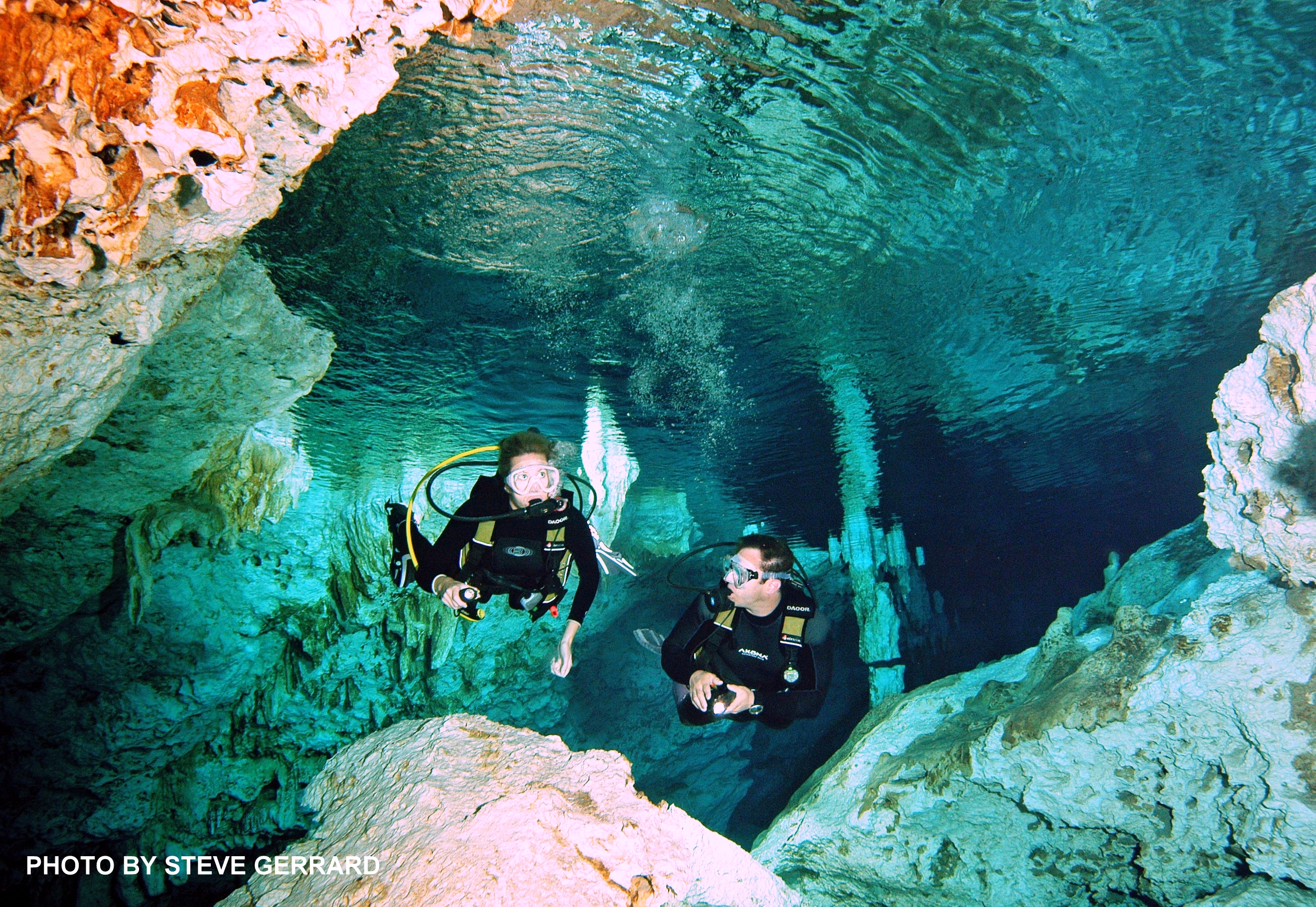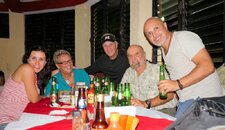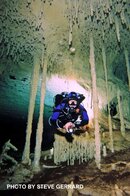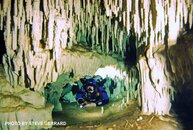Stevegerrard
Registered
By STEVE PENN GERRARD
Before diving a cenote you need to know the risks and your limitations. Any scuba diver who plans to dive a cenote should understand the difference between a safe cavern dive and an open water dive. Open water simply means any body of water using SCUBA which allows a direct ascent to the surface. A cavern dive in a cenote means diving into an overhead environment which does not allow a direct ascent to the surface. To safely dive the cavern zone the scuba diver should either be trained or certified as a cavern diver or participate in a cenote dive with a qualified professional cavern diving guide.
The international scuba diving training agencies such as PADI, IANTD, NAUI, GUI, SSI, TDI, YMCA, PDIC, SDI, CMAS, etc. makes it clear no open water instructor may take a student into any type of overhead environment. Yet, despite the risks and warnings many open water instructors are taking their open water students into the overhead environment. This is a serious and direct violation of the international certification agency’s training standards and a potentially dangerous situation.
Another life threatening situation in the cenotes of the Riviera Maya involves open water divers not trained and certified in cavern or cave diving bringing underwater lights with them and venturing into the cavern and cave zones of the cenote. This unsafe conduct can lead to drowning accidents.
In the state of Florida, sinkhole and spring diving is very popular. One solution to the problem of unqualified divers going into the caverns and caves is the: “The No Light Rule. All of the state parks, national forests, private camp grounds and several land owners who have underwater caves on their property apply this very successful rule of diving in the overhead environment. If the diver is not certified in cavern or cave diving, they are not allowed in the water with a light. When the diver arrives at these dive sites, posted signs and/or written waiver forms carefully explain this policy. Divers are asked to show their certification qualifications. Only qualified, cavern divers are allowed to take lights into the caverns or caves. This simple rule has helped reduced accidents and saved lives during the past thirty years. It is a huge success!
Cenote diving has rapidly evolved into a very popular type of diving for divers traveling to the Riviera Maya in Mexico. Simply stated, a cenote dive is a CAVERN dive, diving the "overhead environment" within the limits of natural sunlight. Following established guidelines will help make a cenote dive safe and easy to enjoy. Cavern divers should always stay within 200 feet/61 meters linear distance of the cavern entrance and go no deeper than 70 feet/21 meters in depth. Fortunately, all of the popular cenote dives in the Riviera Maya are very shallow.
A popular safety theme of "Accident Analysis" is constantly emphasized. The key in safe cavern diving involves a continuous guideline (used as an additional safety navigational tool with the daylight), allowing 2/3rd's of your air supply to safely exit the cavern zone and using a minimum of three lights with the sunlight being your outside source and two battery powered lights (using one as your primary light).
ONE CONTINUOUS GUIDELINE
Most cenote dive locations have a permanently installed rope which serves as a great psychological reference. If no permanent guideline exists then the qualified cavern guide can temporarily install a guideline during the cavern tour. This string is a very important part of a safe cenote dive and should never be taken for granted.
AIR/GAS SUPPLY
The air supply must be managed. When a diver voluntarily enters the cavern zone it is imperative that he or she allow enough air to exit and plan for any unseen emergencies. The "classic" 1/3 air/gas in and 2/3rd's air/gas out has been an established procedure since the early 1970's. The limitations of the cavern zone demand that all the divers exit with at least a minimum 1200 psi/80 bar, no less. This valuable cushion creates the time to safely handle an unplanned problem or delay when diving the "overhead environment". You can certainly continue your dive in the open water area to enjoy more of the beautiful cenote basin where many species of fresh-water tropical fish, turtles and aquatic plant life live.
The Cavern Tour has quickly evolved into the hottest and most popular way for open water divers to have the opportunity to experience this unique and incredibly beautiful type of diving in the Yucatan cenotes. The dive should be organized around a professional, qualified guide. The guide must be Full Cave certified and should be a minimum Divemaster qualified. The guide should also be experienced in cave diving and be very knowledgeable about the local cenotes.
Because most diving visitors to the Riviera Maya are on a one week vacation or a brief few days, this type of diving gives the chance to participate and witness a pristine environment without having to invest in more training and equipment. For those who are so enchanted and thrilled by this unique underwater world and wish to seriously pursue more, training is readily available in the form of cavern, Intro to Cave and complete cave diving training. This training can be accomplished in many different formats suitable to your time and comfort level.
The Cavern Diving Course
The cavern diving course requires a minimum of two/3 days of training developing the minimum skills and knowledge for safe cavern diving. The course describes the dangers involved with cave diving. It also covers planning; the environment, procedures, techniques, problem solving and other specialized needs.
Problem solving covers buoyancy control, body positioning, emergency procedures, following guide lines, and swimming techniques. Specific emphasis is placed on silting, entanglement, disorientation, and equipment modifications for this unique environment.
Classroom instruction cover the contents of safe policies of cavern diving, the environment, accident analysis, psychological aspects, equipment, techniques, body control and emergency procedures. During the course both land and open water drills will involve the use of guidelines, following the guideline as a navigational tool, following the line with no visibility, and emergency procedures including sharing air.
A minimum of four cavern dives will be conducted using a minimum of three different caverns.
During these dives the following will be performed:
a. Safety drill (practice sharing air, check valves and equipment on each dive).
b. Demonstrate proper buoyancy control and body positioning with minimum weighting and distribution.
c. Demonstrate good propulsion techniques.
d. Guideline awareness and the use of the reel and line.
e. Enjoy and explore the cavern gaining confidence and being comfortable.
The safe limits of a cavern are:
a. Natural daylight.
b. 200 feet/60 meters linear distance.
c. 70 feet/ 21 meters maximum depth
d. 40 feet/12 meters minimum visibility.
e. No decompression diving.
f. No restrictions.
Certified cavern divers must use all necessary equipment considered appropriate for open water diving but also include two battery powered lights and a reel and guideline. The snorkel is not used. The Introduction to Cave course is another two/3 days of diving involving 4 - 5 limited cave dives based on the single tank format. The course reviews the information provided from the cavern course and delves deep into safe diving philosophy along with allowing the student to see and experience the cave system beyond natural daylight. For those students who wish to complete their cave diving training and use double tanks, the Full Cave course introduces complex dives using jumps, gaps and jumps, permanent intersections, circuit/traverse dives and decompression procedures. For those divers who know they want to pursue complete cave diving training and do all the training at one time, the one week cave diving course provides the opportunity.
Cenote diving is exciting and fun. The spectacular beauty and pristine environment awaits the open water diver. Experienced divers comment that the cenote dive was one of the best dives they have ever made. These sacred waters will instill a new desire for fun and safe diving.
The popularity of the cenotes has transformed The Riviera Maya into a major destination for divers from all around the world. As more and more divers hear about and discover the tranquil beauty of these pristine “windows” to the underwater world, the number of divers will impact these precious and fragile ecosystems. Safety and awareness of the environment are paramount in educating both the cenote guide and the visiting divers. The Cavern course, by far, is the most popular course.
Before diving a cenote you need to know the risks and your limitations. Any scuba diver who plans to dive a cenote should understand the difference between a safe cavern dive and an open water dive. Open water simply means any body of water using SCUBA which allows a direct ascent to the surface. A cavern dive in a cenote means diving into an overhead environment which does not allow a direct ascent to the surface. To safely dive the cavern zone the scuba diver should either be trained or certified as a cavern diver or participate in a cenote dive with a qualified professional cavern diving guide.
The international scuba diving training agencies such as PADI, IANTD, NAUI, GUI, SSI, TDI, YMCA, PDIC, SDI, CMAS, etc. makes it clear no open water instructor may take a student into any type of overhead environment. Yet, despite the risks and warnings many open water instructors are taking their open water students into the overhead environment. This is a serious and direct violation of the international certification agency’s training standards and a potentially dangerous situation.
BRUCE & KATRINA 033
This photo is taken in the area between Cenote Dos Ojos East and Cenote Dos Ojos West. This...
Another life threatening situation in the cenotes of the Riviera Maya involves open water divers not trained and certified in cavern or cave diving bringing underwater lights with them and venturing into the cavern and cave zones of the cenote. This unsafe conduct can lead to drowning accidents.
In the state of Florida, sinkhole and spring diving is very popular. One solution to the problem of unqualified divers going into the caverns and caves is the: “The No Light Rule. All of the state parks, national forests, private camp grounds and several land owners who have underwater caves on their property apply this very successful rule of diving in the overhead environment. If the diver is not certified in cavern or cave diving, they are not allowed in the water with a light. When the diver arrives at these dive sites, posted signs and/or written waiver forms carefully explain this policy. Divers are asked to show their certification qualifications. Only qualified, cavern divers are allowed to take lights into the caverns or caves. This simple rule has helped reduced accidents and saved lives during the past thirty years. It is a huge success!
Cenote diving has rapidly evolved into a very popular type of diving for divers traveling to the Riviera Maya in Mexico. Simply stated, a cenote dive is a CAVERN dive, diving the "overhead environment" within the limits of natural sunlight. Following established guidelines will help make a cenote dive safe and easy to enjoy. Cavern divers should always stay within 200 feet/61 meters linear distance of the cavern entrance and go no deeper than 70 feet/21 meters in depth. Fortunately, all of the popular cenote dives in the Riviera Maya are very shallow.
A popular safety theme of "Accident Analysis" is constantly emphasized. The key in safe cavern diving involves a continuous guideline (used as an additional safety navigational tool with the daylight), allowing 2/3rd's of your air supply to safely exit the cavern zone and using a minimum of three lights with the sunlight being your outside source and two battery powered lights (using one as your primary light).
ONE CONTINUOUS GUIDELINE
Most cenote dive locations have a permanently installed rope which serves as a great psychological reference. If no permanent guideline exists then the qualified cavern guide can temporarily install a guideline during the cavern tour. This string is a very important part of a safe cenote dive and should never be taken for granted.
AIR/GAS SUPPLY
The air supply must be managed. When a diver voluntarily enters the cavern zone it is imperative that he or she allow enough air to exit and plan for any unseen emergencies. The "classic" 1/3 air/gas in and 2/3rd's air/gas out has been an established procedure since the early 1970's. The limitations of the cavern zone demand that all the divers exit with at least a minimum 1200 psi/80 bar, no less. This valuable cushion creates the time to safely handle an unplanned problem or delay when diving the "overhead environment". You can certainly continue your dive in the open water area to enjoy more of the beautiful cenote basin where many species of fresh-water tropical fish, turtles and aquatic plant life live.
The Cavern Tour has quickly evolved into the hottest and most popular way for open water divers to have the opportunity to experience this unique and incredibly beautiful type of diving in the Yucatan cenotes. The dive should be organized around a professional, qualified guide. The guide must be Full Cave certified and should be a minimum Divemaster qualified. The guide should also be experienced in cave diving and be very knowledgeable about the local cenotes.
Because most diving visitors to the Riviera Maya are on a one week vacation or a brief few days, this type of diving gives the chance to participate and witness a pristine environment without having to invest in more training and equipment. For those who are so enchanted and thrilled by this unique underwater world and wish to seriously pursue more, training is readily available in the form of cavern, Intro to Cave and complete cave diving training. This training can be accomplished in many different formats suitable to your time and comfort level.
The Cavern Diving Course
The cavern diving course requires a minimum of two/3 days of training developing the minimum skills and knowledge for safe cavern diving. The course describes the dangers involved with cave diving. It also covers planning; the environment, procedures, techniques, problem solving and other specialized needs.
Problem solving covers buoyancy control, body positioning, emergency procedures, following guide lines, and swimming techniques. Specific emphasis is placed on silting, entanglement, disorientation, and equipment modifications for this unique environment.
Classroom instruction cover the contents of safe policies of cavern diving, the environment, accident analysis, psychological aspects, equipment, techniques, body control and emergency procedures. During the course both land and open water drills will involve the use of guidelines, following the guideline as a navigational tool, following the line with no visibility, and emergency procedures including sharing air.
A minimum of four cavern dives will be conducted using a minimum of three different caverns.
During these dives the following will be performed:
a. Safety drill (practice sharing air, check valves and equipment on each dive).
b. Demonstrate proper buoyancy control and body positioning with minimum weighting and distribution.
c. Demonstrate good propulsion techniques.
d. Guideline awareness and the use of the reel and line.
e. Enjoy and explore the cavern gaining confidence and being comfortable.
The safe limits of a cavern are:
a. Natural daylight.
b. 200 feet/60 meters linear distance.
c. 70 feet/ 21 meters maximum depth
d. 40 feet/12 meters minimum visibility.
e. No decompression diving.
f. No restrictions.
Certified cavern divers must use all necessary equipment considered appropriate for open water diving but also include two battery powered lights and a reel and guideline. The snorkel is not used. The Introduction to Cave course is another two/3 days of diving involving 4 - 5 limited cave dives based on the single tank format. The course reviews the information provided from the cavern course and delves deep into safe diving philosophy along with allowing the student to see and experience the cave system beyond natural daylight. For those students who wish to complete their cave diving training and use double tanks, the Full Cave course introduces complex dives using jumps, gaps and jumps, permanent intersections, circuit/traverse dives and decompression procedures. For those divers who know they want to pursue complete cave diving training and do all the training at one time, the one week cave diving course provides the opportunity.
Cenote diving is exciting and fun. The spectacular beauty and pristine environment awaits the open water diver. Experienced divers comment that the cenote dive was one of the best dives they have ever made. These sacred waters will instill a new desire for fun and safe diving.
The popularity of the cenotes has transformed The Riviera Maya into a major destination for divers from all around the world. As more and more divers hear about and discover the tranquil beauty of these pristine “windows” to the underwater world, the number of divers will impact these precious and fragile ecosystems. Safety and awareness of the environment are paramount in educating both the cenote guide and the visiting divers. The Cavern course, by far, is the most popular course.








